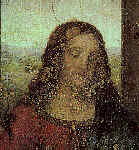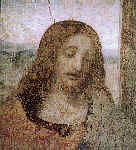After Today's
Restoration of the "Cena", |
|
|
L'ULTIMA CENA |
| Leonardo da Vinci's "Last Supper" |
| Twenty years of opposition to restoration of
Leonardo da Vinci's Last Supper by one of the greatest exponents of contemporary art |
|
MARIO
DONIZETTI:
WHY I HAVE DISPUTED AND CONTINUE TO DISPUTE THE INTERVENTION FOR CLEANING |
 |
The head of Jesus
before the current restoration. |
 |
The head of Jesus after the current
restoration. The anatomy of Jesus' head has been changed. The "cleaning" job has made extremely important details disappear. These were put in by Leonardo using "glazing" (with "bright colours") over the first layer of "dull colours" which, as per tradition, was done by the pupils. The "cleaning", carried out by the current restorers using solvents, has therefore brought the head of Jesus back out as it was in the first draft, which a genius such as Leonardo would never have "left" as his own. Leonardo had modified the first draft with his own hand, putting light into the hair around the profile of the skull. This light rounded off the head. The dark "re-integration" of the gaps, which has replaced the light in that area, now notably modifies the anatomy of the skull. To "re-integrate the gaps", the figure needs to be interpreted. On Jesus, the interpretation of Leonardo's shape has been made according to the anatomical, technical and spiritual knowledge of the restorers. Re-integration of the missing parts of this masterpiece is an operation which even Leonardo could never have carried out. For an artist, it is one thing to draw a line to outline a part of the anatomy and quite another to carry out "puntinatura" on the missing parts of an existing line. |
© Mario Donizetti all rights reserved